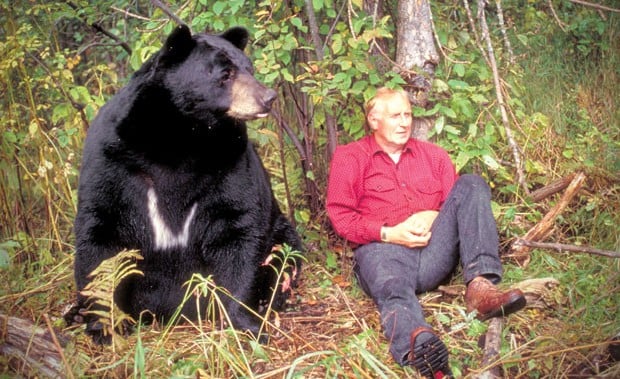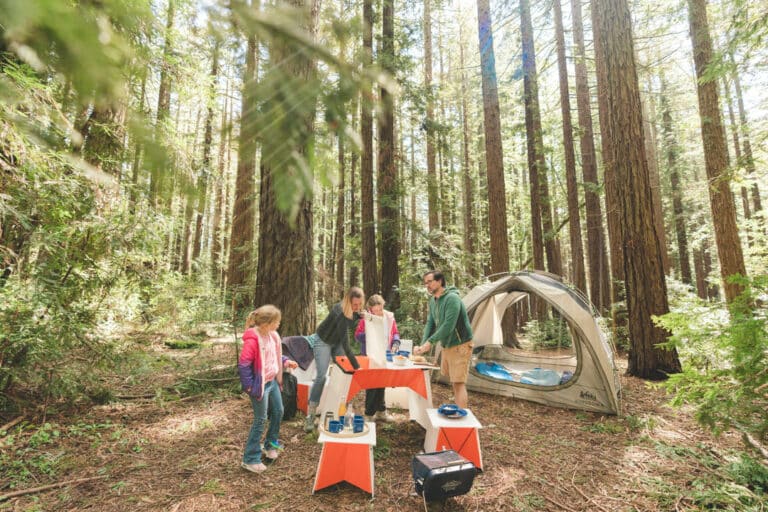This lack of detachment is what leaves Rogers open to critics. “When you’re dealing with behavioral research, you want to make sure you don’t change the behavior of the animal,” explains the U.S. Geological Survey’s van Manen. “It would be very difficult to not change the behavior of the animal when you’re right there with the animal or when there’s food involved.”
Rogers argues that this was the same sort of criticism directed at Jane Goodall, the world-renowned primatologist who pioneered the study of chimpanzee behavior. And since black bears are solitary animals that are difficult to track, Rogers believes his hands-on field studies are the best way to record behavior, development, and social interaction.
Rogers’ scariest moments are during hunting season. “It’s a very scary time,” he says. “We try to stay with the bears to protect them.”
It’s hard for them to see hunters, who are dressed head to toe in camouflage, and it’s hard for hunters to see them, through the forest’s thick curtain of leaves. So the researchers are just as likely to be shot as the bears they pursue.
Rogers’s brand of extreme science is seen by some as just plain reckless. But it’s hard to deny that good research has come out of it. Close contact with bears has resulted in the first-ever video footage of a wild bear giving birth. Rogers and his colleagues set up a “den cam,” which also allowed scientists to observe hibernation. They learned that bears wake up during the winter to play or eat snow, contrary to previous assumptions. Rogers’s research center also snagged the first-ever footage of wild bears mating, dispelling beliefs that this is an especially dangerous time to encounter bears.
His research has also revealed certain aspects of bear diets. Rogers has found that bears show a preference for plants like jewelweed, clovers, and wild calla. Close observation was necessary for this determination since highly digestible foods don’t appear in bear droppings the way berries, nuts, or insect larvae do.
His most powerful finding is that bears are not as threatening as television, movies, and hunting magazines would have us believe. “If the stuff I was saying was wrong, I’d be dead by now.
What We Can Learn From Black Bears
1. What we can learn from bear body control Bears can regulate temperatures in variable cycles during hibernation. Bears’ body temperatures fell by 43°F, their heart rates slowed from about 55 beats-per-minute to 14 beats-per-minute, and their metabolism dropped by 75 percent. After waking up, the bears’ metabolism remained at low levels for up to three weeks, indicating the presence of a biochemical mechanism at work. Biologists believe these findings bring us one step closer to determining how hibernation-like states can be induced in humans.
2. What we can learn from bear bones Even after months of inactivity during hibernation, black bears exhibit very little loss in bone and muscle mass, allowing them to become physically active almost immediately. Bears may work their muscles during hibernation by shivering or isometric activity. Understanding these mechanisms could lead to new treatments for osteoporosis and disuse atrophy. NASA also funds bear research to help astronauts fight muscle and bone loss in space.
3. What we can learn from bear breaths When hibernating black bears breathe in, they can increase their heart rate by 800 percent; when humans breathe, they can only increase their heart rate by 20 percent. Scientists believe that mimicking bears’ “respiratory sinus arrhythmia” could benefit humans with poor heart function.
4. What we can learn from bear kidneys During hibernation, bears can go for months without urinating. Unlike in humans, bears’ microbes successfully recycle the waste urea in urine. Humans’ microbes don’t work as effectively, so the inability to recycle urea causes kidney failure. As a result, doctors from Harvard Medical School are conducting further research of bear kidneys.
5. What we can learn from bear biochemistry Hibernation allows bears to take in less oxygen without harming the brain or heart. It’s triggered by opiate-like compounds called deltorphins, which have been found to help mice and rats survive strokes, severe hemorrhaging, and heart attacks. Understanding their possible activity in bears could lead to use of these compounds in human medicines.








